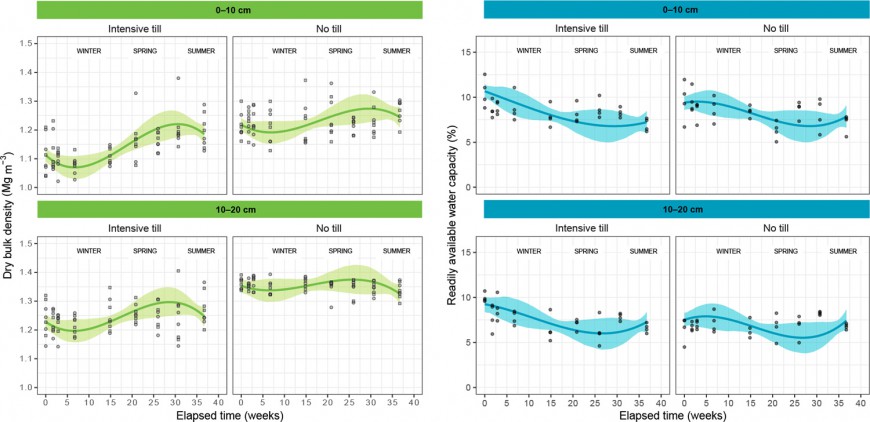Temporal changes in soil physical properties under winter wheat cropping
Accurate representation of soil water storage and movement is important for the management of diffuse nutrient discharges from agriculture. The widely used OVERSEER model, for example, is very sensitive to changes in soil available water capacity data, which are supplied from S-map. This study investigated temporal changes in soil physical properties for intensive till and no till irrigated wheat, from autumn sowing to summer harvest.
The field site was at the Foundation for Arable Research’s Chertsey site’s long-term cultivation trial, in Canterbury. The soil was a Templeton silt loam over gravels (Typic Immature Pallic Soil). The trial was sown with wheat in April 2015, irrigated in late spring and summer, and harvested in February 2016. The no till treatment was direct drilled, and the intensive till treatment was cultivated with a ‘Topdown’ plough, and then drilled. Soil physical samples were collected over nine samplings (May–January) from 0−10 cm and 10−20 cm depths and analysed at the Manaaki Whenua – Landcare Research Soil Physics Laboratory.
Here we present temporal trend results for bulk density and readily available water capacity (RAWC). Temporal trends were fitted using a statistical mixed-effect model. Temporal trends in bulk density and RAWC are presented in Figure 1(a) and 1(b), respectively. The temporal trend shows curvature for intensive till but is less obvious for the no till treatment. For intensive till, the trend indicates a possible reduction in bulk density during the first 5–10 weeks, and overall increasing bulk density over time.

Figure 1 Measured (markers) and modelled (line) for (a) bulk density and (b) readily available water capacity. The solid line is the predicted mean bulk density. The shaded area is the 95% confidence interval of the mean predicted response. Time elapsed i
The temporal trend in readily available water capacity also showed changes for intensive till and no till. RAWC to 20-cm depth for the intensive till management, for example, reduced from about 9.9% on a volume basis (equivalent to 20-mm water storage) at the start of the trial, to 7.3% (equivalent to 14-mm water storage), representing a relative decrease of 26%, or an equivalent to 5-mm water storage.
The change in RAWC could have some practical implications for irrigation management, such as the potential need to irrigate sooner than might otherwise occur. However, the irrigation started after some initial reduction in the RAWC had occurred over winter, so the practical difference in RAWC during the irrigation season is about half the value (namely about 3 mm) of that indicated above. The differences in RAWC are likely to be too small to be of practical concern to many farmers.
This study improves our knowledge of temporal changes in soil physical properties, as these are of interest to improving models, and simulation of soil water storage, movement and nutrient supply, and therefore future scenario modelling.
Further reading:
Drewry JJ, McNeill SJ, Carrick S, Lynn IH, Eger A, Payne J, Rogers G, Thomas SM 2019. Temporal trends in soil physical properties under cropping with intensive tillage and no-till management. New Zealand Journal of Agricultural Research. https://doi.org/10.1080/00288233.2019.1684323


